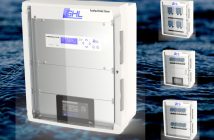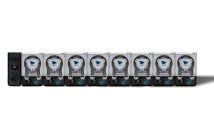Back in September, AquaNerd contributor Keith Hatch stumbled upon a brand new open top aquarium from Deep Sea Aquatics (DSA) called the Neo Storm. The aquarium, which is basically a beefed up version of the Neo Nano, was first spied at the Super Zoo pet show in Las Vegas, and despite looking very similar to its smaller predecessor, the Storm has some fancy new features that allow for better water flow while still keeping the surface virtually ripple-free for optimum look down viewing. When we first laid eyes on the tank and heard a few details about its return plumbing, we weren’t exactly sure how it would all work. We weren’t doubting its abilities, rather we were curious how water was going from the rear chamber to the front two outlets. Fortunately, the guys at DSA have released a “how to” video demonstrating the proper setup of this tank, which clears away all confusion about how it operates.
The back wall of the Neo Storm aquarium, which is significantly taller than the rest of the tank, holds a three chamber drain and return system. The two smaller chambers that flank the much taller middle chamber serve as dual drains into the sump. The tall middle chamber is the return, which is where the Neo Storm stands apart from the Neo Nano. In the older Neo Nano, the water simply fills the chamber and flows over the top like a waterfall. This water was pushed over the chamber slow enough to be dead silent and not create a lot of surface movement, but the tank obviously lacked any real water flow. The Neo Storm, on the other hand, modifies the concept by pushing water both through holes in the chamber (which are submerged) and through two outlets toward the front corners at the bottom tank. As the chamber fills, gravity causes the pressure to build up forcing water through soft plumbing and gently out of the two return fittings. But not wanting to limit flow options for customers, DSA did something rather ingenious. They put multiple holes in the return chamber of the Neo Storm, but also included plastic fittings to fill these holes. The more holes that are plugged, the greater the pressure is within the chamber and the more water will be pushed out of the two returns at the front of the tank.





